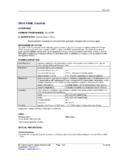Transcription of Guidelines for Management of CID - BC Cancer
1 BCCA Guidelines for Management of Chemotherapy-induced Diarrhea Introduction Patients receiving chemotherapy or radiation are at high risk for developing diarrhea, which is estimated to be as high as 45% with chemotherapeutic drugs like irinotecan or 5-fluorouracil (5FU). This side effect often leads to delay in treatment, dose reduction or discontinuation of treatment. There is a small but significant mortality associated with chemotherapy-induced diarrhea (CID), especially when it occurs concomitantly with mucositis and neutropenia. Classification CID is graded using the NCI criteria (Table 1) which grades diarrhea on a scale of 0.
2 (normal) to 4 (severe) according to the number of loose stools/days, presence of nocturnal stools, incontinence, cramping and blood in stools. Table 1 NCI criteria for assessment of chemotherapy-induced diarrhea Grade 0 1 2 3 4. No. of Normal 2 3 4-6 7-9 >10. stools/day Symptom - - Nocturnal Incontinence Bloody stool stools - - Moderate Severe Need for cramping cramping parenteral fluid support Risk factors Certain factors appear to be associated with an increased incidence of CID. Patient factors Older age Female gender Lower performance status (ECOG 2 or more). Associated bowel pathology ( colitis, lactose intolerance).
3 Presence of tumor in bowel Therapy-related factors Drugs: irinotecan and 5FU. Weekly chemotherapy schedule Infusional chemotherapy Prior history of CID. Concomitant abdominal-pelvic radiation and chemotherapy Disclaimer Both the format and content of the Guidelines will change as they are reviewed and revised on a periodic basis. Any physician using these Guidelines to provide treatment for patients will be solely responsible for verifying the doses, providing the prescriptions and administering the medications described in the Guidelines according to acceptable standards of care.
4 Management CID can be a serious complication and requires prompt assessment. The steps in this assessment are as follows: 1. Rule out other or concomitant causes of diarrhea Other causes of diarrhea must be ruled out. These include medications ( stool softeners, laxatives, antacids, etc), infection by C. difficile or Candida species, partial bowel obstruction, malabsorption, fecal impaction, acute radiation reaction and surgery (short bowel syndrome). Diets high in fiber or lactose may aggravate diarrhea. 2. Dietary modifications during diarrhea Mild diarrhea may be managed with diet to decrease the frequency of stools.
5 Patients should be advised to increase intake of clear fluids ( water, sports drinks, broth, gelatin, clear juices, decaffeinated tea, caffeine-free soft drinks). A BRAT (banana, rice, apples, toast) diet can be helpful. (Note that patients who develop diarrhea while on irinotecan chemotherapy should be treated promptly with high-dose loperamide as outlined below, and dietary Management alone is inadequate.). 3. Medications a. Loperamide Loperamide is indicated for Grade 1 diarrhea that persists for more than 12-24 hours or for moderate diarrhea (Grade 2). The standard dose of loperamide is 4 mg followed by 2 mg every 4 hours or after each unformed stool (maximum dose 16 mg/day).
6 This dose may be increased in patients with mild to moderate diarrhea (Grade 1 or 2) that persists for more than 24 hours. The dose is 4 mg to start, followed by 2 mg every 2 hours (or 4. mg every 4 hours at night to allow sleep). Loperamide should be continued for 12 hours following resolution of the diarrhea and re-establishment of a normal diet. High-dose loperamide (4 mg followed by 2 mg every 2 hours) is also recommended at the onset of any diarrhea in patients receiving irinotecan chemotherapy. b. Atrophine-diphenoxylate (Lomotil ). At the discretion of the treating physician, it may be useful to add atropine- diphenoxylate 1 to 2 tablets, every 6-8 hours, to loperamide therapy for Grade 1 or 2.
7 Diarrhea. It should not be expected that this would be sufficient for the Management of Grade 3 or 4 diarrhea. c. Octreotide For Grades 1 and 2 diarrhea lasting more than 24 hours despite high-dose loperamide +. atrophine-diphenoxylate, octreotide 100-150 mcg SC TID may be considered (Table 2). For Grades 3 and 4 diarrhea, octreotide 150 mcg SC TID is indicated; these patients usually require hospitalization (Table 3). If there is no improvement in the diarrhea after 24 hours, the dose of octreotide should be increased to 300-500 mcg SC TID. The Disclaimer Both the format and content of the Guidelines will change as they are reviewed and revised on a periodic basis.
8 Any physician using these Guidelines to provide treatment for patients will be solely responsible for verifying the doses, providing the prescriptions and administering the medications described in the Guidelines according to acceptable standards of care. duration of octreotide therapy should be individualized, but can be discontinued 24. hours after the end of diarrhea and re-establishment of a normal diet. d. Antibiotics In the presence of concomitant neutropenia (granulocytes <1 X 106/L), antibiotics ( ciprofloxacin 500 mg BID) should be considered until resolution of diarrhea and recovery of the granulocyte counts.
9 Table 2 Management of Grades 1 and 2 chemotherapy-induced diarrhea Grades 1-2 Diarrhea: Acute Management Grades 1-2 diarrhea Dietary Management Loperamide - standard dosing (4 mg + 2 mg after each loose stool;. max. 16 mg/day). Diarrhea resolved Diarrhea not resolved - Adjust diet - High-dose loperamide - Discontinue loperamide (4 mg + 2 mg q2h). after 12 hours without diarrhea Diarrhea not resolved after 24 hours Octreotide 100-150 g TID. Replace fluids/electrolytes Disclaimer Both the format and content of the Guidelines will change as they are reviewed and revised on a periodic basis.
10 Any physician using these Guidelines to provide treatment for patients will be solely responsible for verifying the doses, providing the prescriptions and administering the medications described in the Guidelines according to acceptable standards of care. Table 3 Management of grade 3-4 chemotherapy-induced diarrhea Grades 3-4 Diarrhea: Acute Management Grades 1-2 diarrhea Grades 3-4 diarrhea progressing to Grades 3-4. Admit to hospital Admit to hospital Octreotide 100-150 g TID Octreotide 100-150 g TID. IV fluids + antibiotics as needed IV fluids + antibiotics as needed Call Dr.















